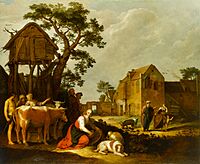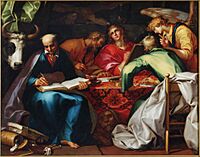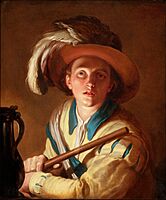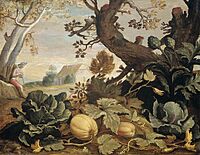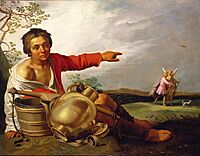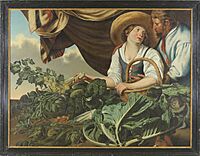Abraham Bloemaert facts for kids
Quick facts for kids
Abraham Bloemaert
|
|
|---|---|
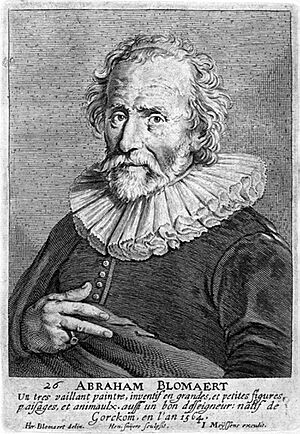
Abraham Bloemaert by Hendrick Snyers for Het Gulden Cabinet, p. 45
|
|
| Born |
Abraham Bloemaert
25 December 1566 Gorinchem
|
| Died | 27 January 1651 (aged 84) Utrecht
|
| Nationality | Dutch |
| Education | Hieronymus Francken among others |
| Known for | Printmaking, paintings |
| Movement | Northern Mannerism and Dutch Baroque painting |
Abraham Bloemaert (born December 25, 1566 – died January 27, 1651) was an important Dutch artist. He was a skilled painter and printmaker. He created art using methods like etching and engraving.
At first, he painted in a style called "Haarlem Mannerism". But around the year 1600, his style changed. He began to paint in the newer Baroque style. He mostly painted pictures about history and some landscapes. Bloemaert was also a very important teacher. He taught many artists who became known as the Utrecht Caravaggisti.
Contents
His Life as an Artist
Abraham Bloemaert was born in Gorinchem, which was part of the Habsburg Netherlands. His father, Cornelis Bloemaert I, was an architect. In 1575, his family moved to Utrecht. There, young Abraham began to learn painting. His first teachers were Gerrit Splinter and Joos de Beer.
When he was about 15 or 16, Abraham traveled to Paris. He spent three years there, from 1581 to 1583. He studied with artists like Jehan Bassot and Maistre Herry. He also got more training at the School of Fontainebleau from another Dutch artist, Hieronymus Francken.
In 1583, he returned to Utrecht. His father became the city architect in Amsterdam in 1591. Abraham went with him. After his father passed away in 1593, Abraham returned to Utrecht. He opened his own art workshop there.
In 1594, he became a leader, or "deken," of the saddlemakers' guild. Back then, painters were part of this guild. They didn't have their own special guild for artists. But in 1611, Bloemaert helped start a new guild just for painters. It was called the Utrecht Guild of Saint Luke. He became its leader in 1618.
Many of Bloemaert's paintings were made for churches in Utrecht. These were churches that had to meet in secret at the time. He passed away in Utrecht.
What Kind of Art Did He Make?
Bloemaert was known for using colors very well. He painted many different kinds of pictures. These included historical scenes and pictures with hidden meanings. He also painted landscapes, still-life pictures, animals, and flowers.
In the early 1600s, Bloemaert started painting landscapes. He often included old, ruined cottages and other country scenes. In these paintings, people or gods were less important. Country life became his favorite topic. He painted it in a very natural way.
He would draw things like farmhouses and trees from real life. Then, he would go back to his studio. There, he would use his drawings to create complex, imagined scenes.
His Students
Abraham Bloemaert was a very important teacher. Many artists learned from him. Four of his own sons became famous artists too. They were Hendrick, Frederick, Cornelis, and Adriaan Bloemaert.
Other well-known artists who studied with him include:
- Jan van Bijlert
- Jan Both and Andries Both
- Gerhard van Honthorst and his brother
- Leonaert Bramer
- Bartholomeus Breenbergh
- Hendrick ter Brugghen
- Jacob Gerritsz Cuyp
- Nicolaus Knüpfer
- Cornelis van Poelenburch
- Jan Baptist Weenix
Where to See His Art
You can find Abraham Bloemaert's paintings in many art museums around the world. Some of these places include:
- The Detroit Institute of Arts in Michigan
- Fine Arts Museums of San Francisco
- Hermitage Museum in Saint Petersburg, Russia
- Indianapolis Museum of Art in Indiana
- J. Paul Getty Museum in Los Angeles
- Mauritshuis in The Hague, Netherlands
- Metropolitan Museum of Art in New York City
- Museum of Fine Arts, Boston
- Musée du Louvre in Paris, France
- National Gallery of Canada in Ottawa
- Rijksmuseum in Amsterdam, Netherlands
- Royal Academy of Arts in London, UK
- Centraal Museum in Utrecht, Netherlands
- Cleveland Museum of Art in Ohio
- Princeton University Art Museum in New Jersey
Gallery
- Abraham Bloemaert
-
John the Baptist preaching, c. 1620
-
Abraham Bloemaert, Juno, c.1610, National Gallery of Art


